Wireless Networking: Encryption Algorithms, Strengths and Weaknesses
VerifiedAdded on 2023/06/11
|15
|2302
|126
AI Summary
This article discusses the various encryption algorithms used in wireless networking, including DES, AES, RC4, SHA, MD5, PKI, PGP, Blowfish, WEP, WPA, and WPA2. It covers the strengths and weaknesses of each algorithm and also includes a ranking of the algorithms based on their effectiveness.
Contribute Materials
Your contribution can guide someone’s learning journey. Share your
documents today.

Running Head: WIRELESS NETWORKING 0
Student Name
[Type the
company name]
Wireless Networking
Student Name
[Type the
company name]
Wireless Networking
Secure Best Marks with AI Grader
Need help grading? Try our AI Grader for instant feedback on your assignments.
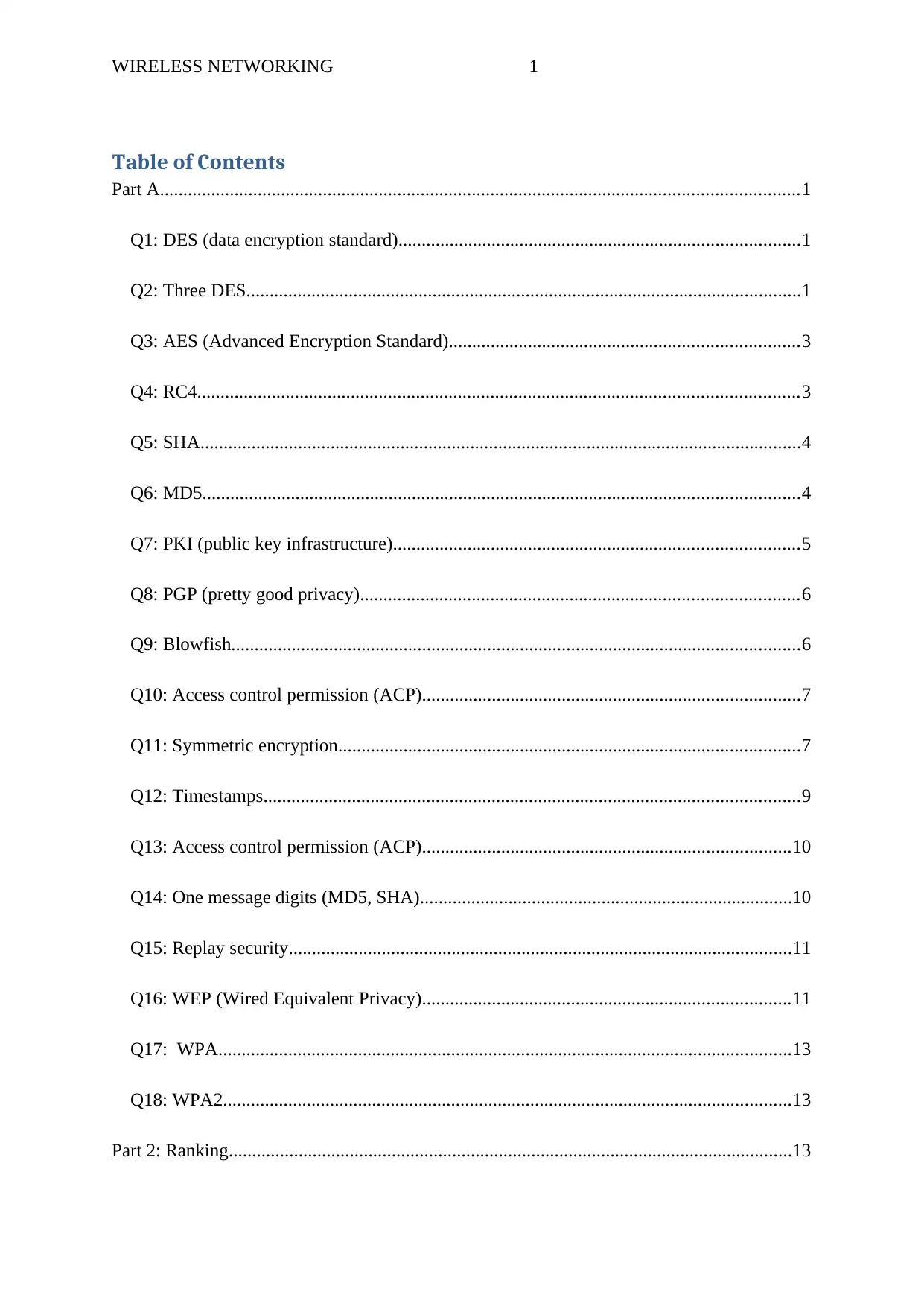
WIRELESS NETWORKING 1
Table of Contents
Part A.........................................................................................................................................1
Q1: DES (data encryption standard)......................................................................................1
Q2: Three DES.......................................................................................................................1
Q3: AES (Advanced Encryption Standard)...........................................................................3
Q4: RC4.................................................................................................................................3
Q5: SHA.................................................................................................................................4
Q6: MD5................................................................................................................................4
Q7: PKI (public key infrastructure).......................................................................................5
Q8: PGP (pretty good privacy)..............................................................................................6
Q9: Blowfish..........................................................................................................................6
Q10: Access control permission (ACP).................................................................................7
Q11: Symmetric encryption...................................................................................................7
Q12: Timestamps...................................................................................................................9
Q13: Access control permission (ACP)...............................................................................10
Q14: One message digits (MD5, SHA)................................................................................10
Q15: Replay security............................................................................................................11
Q16: WEP (Wired Equivalent Privacy)...............................................................................11
Q17: WPA...........................................................................................................................13
Q18: WPA2..........................................................................................................................13
Part 2: Ranking.........................................................................................................................13
Table of Contents
Part A.........................................................................................................................................1
Q1: DES (data encryption standard)......................................................................................1
Q2: Three DES.......................................................................................................................1
Q3: AES (Advanced Encryption Standard)...........................................................................3
Q4: RC4.................................................................................................................................3
Q5: SHA.................................................................................................................................4
Q6: MD5................................................................................................................................4
Q7: PKI (public key infrastructure).......................................................................................5
Q8: PGP (pretty good privacy)..............................................................................................6
Q9: Blowfish..........................................................................................................................6
Q10: Access control permission (ACP).................................................................................7
Q11: Symmetric encryption...................................................................................................7
Q12: Timestamps...................................................................................................................9
Q13: Access control permission (ACP)...............................................................................10
Q14: One message digits (MD5, SHA)................................................................................10
Q15: Replay security............................................................................................................11
Q16: WEP (Wired Equivalent Privacy)...............................................................................11
Q17: WPA...........................................................................................................................13
Q18: WPA2..........................................................................................................................13
Part 2: Ranking.........................................................................................................................13
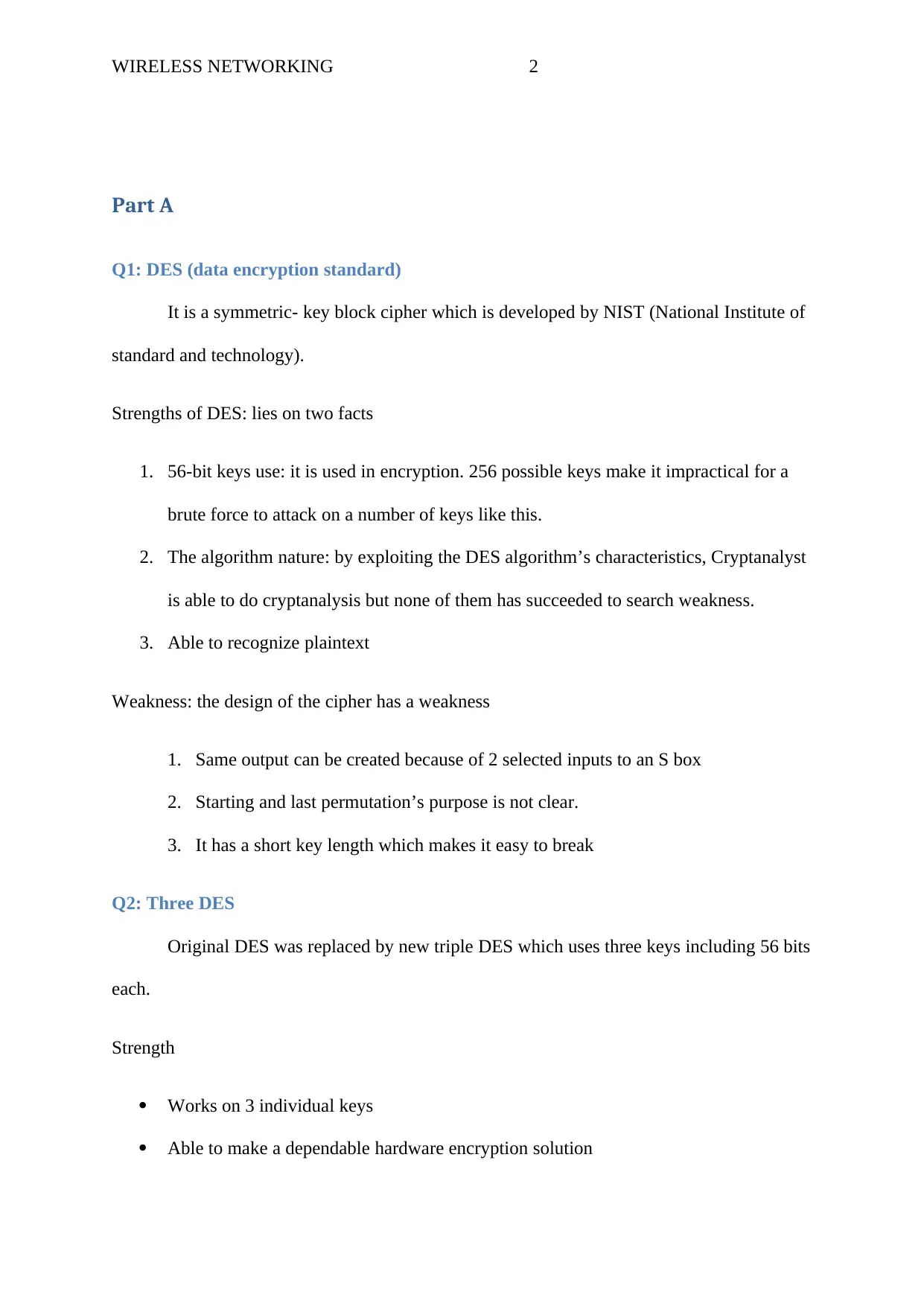
WIRELESS NETWORKING 2
Part A
Q1: DES (data encryption standard)
It is a symmetric- key block cipher which is developed by NIST (National Institute of
standard and technology).
Strengths of DES: lies on two facts
1. 56-bit keys use: it is used in encryption. 256 possible keys make it impractical for a
brute force to attack on a number of keys like this.
2. The algorithm nature: by exploiting the DES algorithm’s characteristics, Cryptanalyst
is able to do cryptanalysis but none of them has succeeded to search weakness.
3. Able to recognize plaintext
Weakness: the design of the cipher has a weakness
1. Same output can be created because of 2 selected inputs to an S box
2. Starting and last permutation’s purpose is not clear.
3. It has a short key length which makes it easy to break
Q2: Three DES
Original DES was replaced by new triple DES which uses three keys including 56 bits
each.
Strength
Works on 3 individual keys
Able to make a dependable hardware encryption solution
Part A
Q1: DES (data encryption standard)
It is a symmetric- key block cipher which is developed by NIST (National Institute of
standard and technology).
Strengths of DES: lies on two facts
1. 56-bit keys use: it is used in encryption. 256 possible keys make it impractical for a
brute force to attack on a number of keys like this.
2. The algorithm nature: by exploiting the DES algorithm’s characteristics, Cryptanalyst
is able to do cryptanalysis but none of them has succeeded to search weakness.
3. Able to recognize plaintext
Weakness: the design of the cipher has a weakness
1. Same output can be created because of 2 selected inputs to an S box
2. Starting and last permutation’s purpose is not clear.
3. It has a short key length which makes it easy to break
Q2: Three DES
Original DES was replaced by new triple DES which uses three keys including 56 bits
each.
Strength
Works on 3 individual keys
Able to make a dependable hardware encryption solution
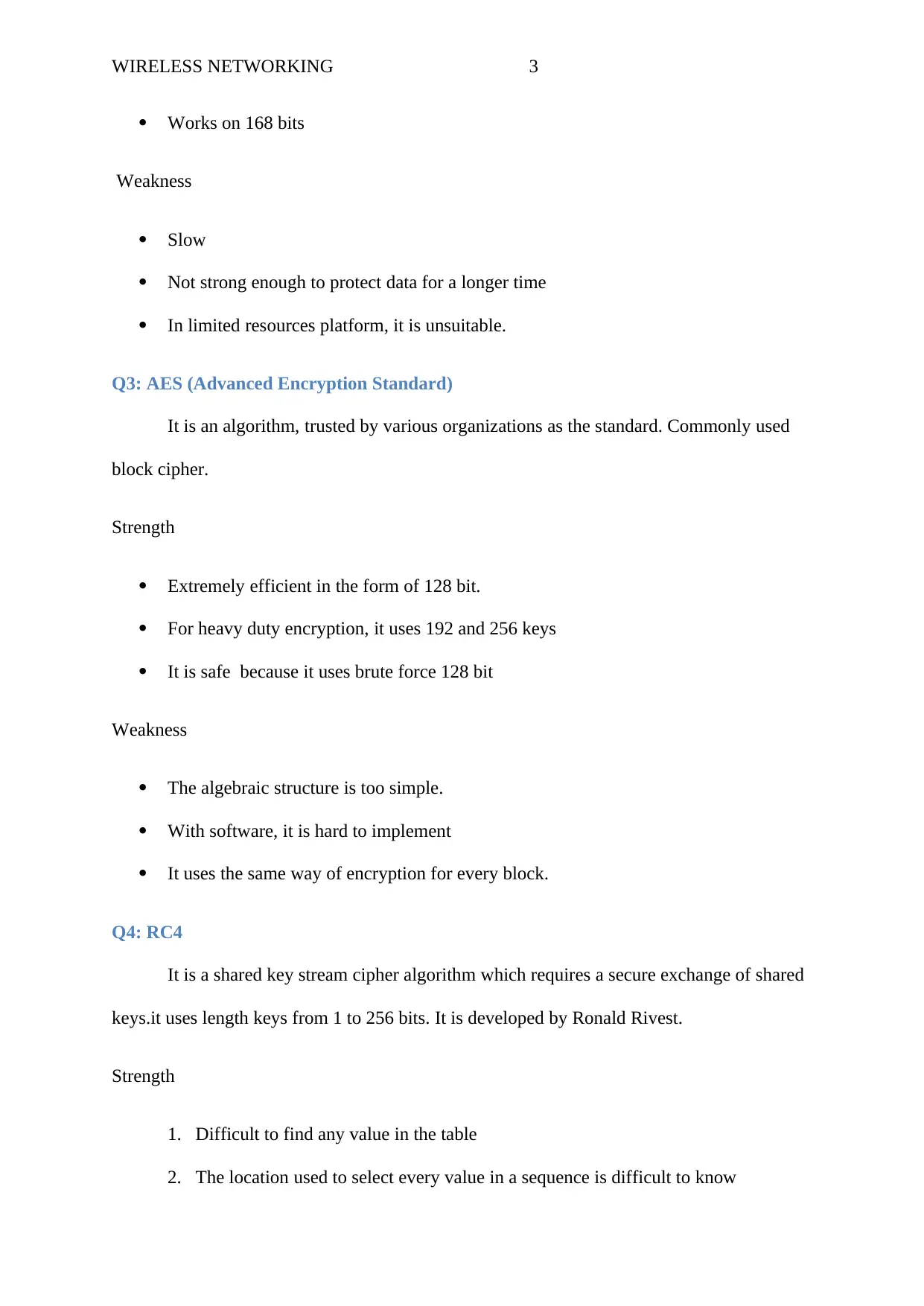
WIRELESS NETWORKING 3
Works on 168 bits
Weakness
Slow
Not strong enough to protect data for a longer time
In limited resources platform, it is unsuitable.
Q3: AES (Advanced Encryption Standard)
It is an algorithm, trusted by various organizations as the standard. Commonly used
block cipher.
Strength
Extremely efficient in the form of 128 bit.
For heavy duty encryption, it uses 192 and 256 keys
It is safe because it uses brute force 128 bit
Weakness
The algebraic structure is too simple.
With software, it is hard to implement
It uses the same way of encryption for every block.
Q4: RC4
It is a shared key stream cipher algorithm which requires a secure exchange of shared
keys.it uses length keys from 1 to 256 bits. It is developed by Ronald Rivest.
Strength
1. Difficult to find any value in the table
2. The location used to select every value in a sequence is difficult to know
Works on 168 bits
Weakness
Slow
Not strong enough to protect data for a longer time
In limited resources platform, it is unsuitable.
Q3: AES (Advanced Encryption Standard)
It is an algorithm, trusted by various organizations as the standard. Commonly used
block cipher.
Strength
Extremely efficient in the form of 128 bit.
For heavy duty encryption, it uses 192 and 256 keys
It is safe because it uses brute force 128 bit
Weakness
The algebraic structure is too simple.
With software, it is hard to implement
It uses the same way of encryption for every block.
Q4: RC4
It is a shared key stream cipher algorithm which requires a secure exchange of shared
keys.it uses length keys from 1 to 256 bits. It is developed by Ronald Rivest.
Strength
1. Difficult to find any value in the table
2. The location used to select every value in a sequence is difficult to know
Secure Best Marks with AI Grader
Need help grading? Try our AI Grader for instant feedback on your assignments.
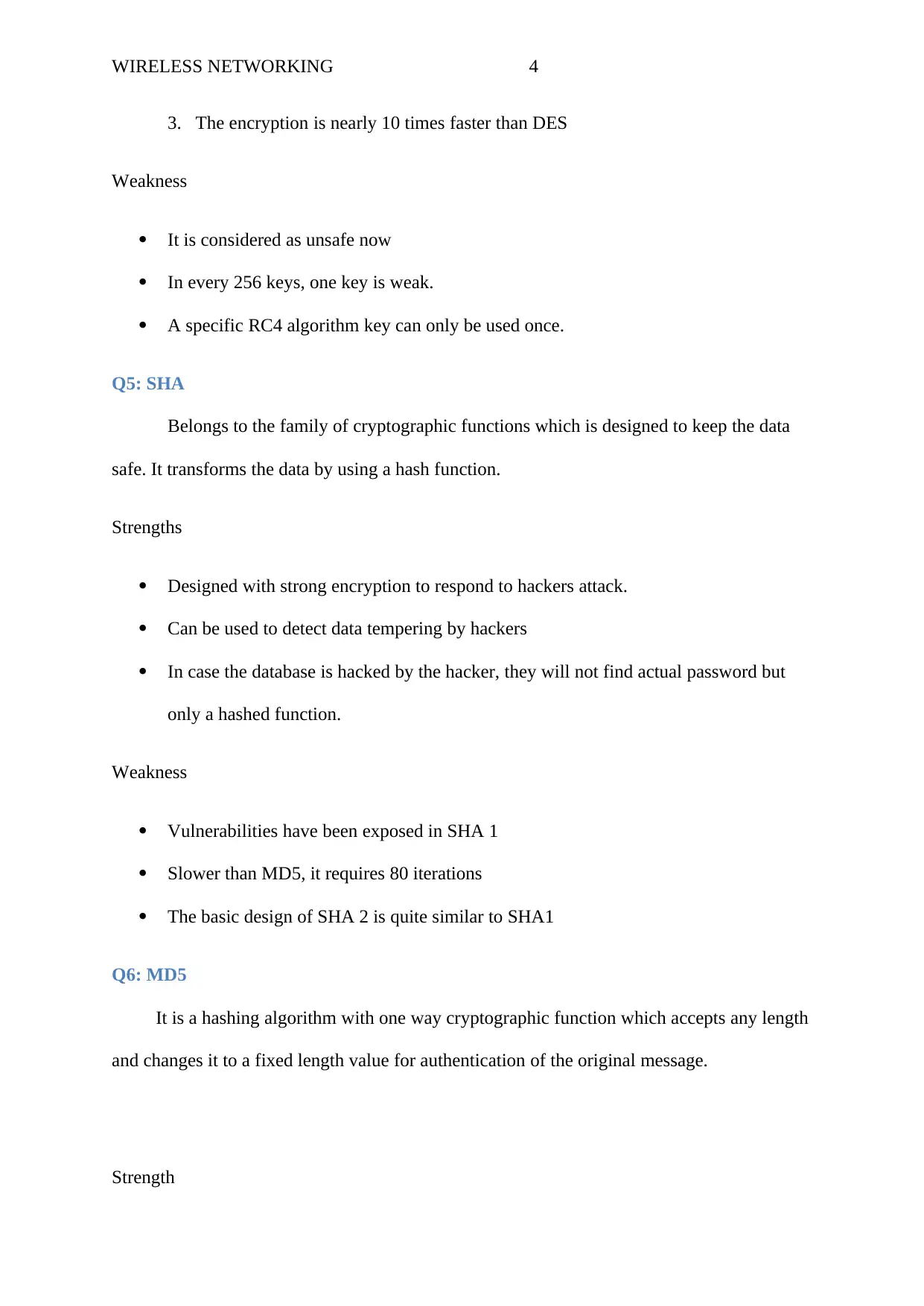
WIRELESS NETWORKING 4
3. The encryption is nearly 10 times faster than DES
Weakness
It is considered as unsafe now
In every 256 keys, one key is weak.
A specific RC4 algorithm key can only be used once.
Q5: SHA
Belongs to the family of cryptographic functions which is designed to keep the data
safe. It transforms the data by using a hash function.
Strengths
Designed with strong encryption to respond to hackers attack.
Can be used to detect data tempering by hackers
In case the database is hacked by the hacker, they will not find actual password but
only a hashed function.
Weakness
Vulnerabilities have been exposed in SHA 1
Slower than MD5, it requires 80 iterations
The basic design of SHA 2 is quite similar to SHA1
Q6: MD5
It is a hashing algorithm with one way cryptographic function which accepts any length
and changes it to a fixed length value for authentication of the original message.
Strength
3. The encryption is nearly 10 times faster than DES
Weakness
It is considered as unsafe now
In every 256 keys, one key is weak.
A specific RC4 algorithm key can only be used once.
Q5: SHA
Belongs to the family of cryptographic functions which is designed to keep the data
safe. It transforms the data by using a hash function.
Strengths
Designed with strong encryption to respond to hackers attack.
Can be used to detect data tempering by hackers
In case the database is hacked by the hacker, they will not find actual password but
only a hashed function.
Weakness
Vulnerabilities have been exposed in SHA 1
Slower than MD5, it requires 80 iterations
The basic design of SHA 2 is quite similar to SHA1
Q6: MD5
It is a hashing algorithm with one way cryptographic function which accepts any length
and changes it to a fixed length value for authentication of the original message.
Strength
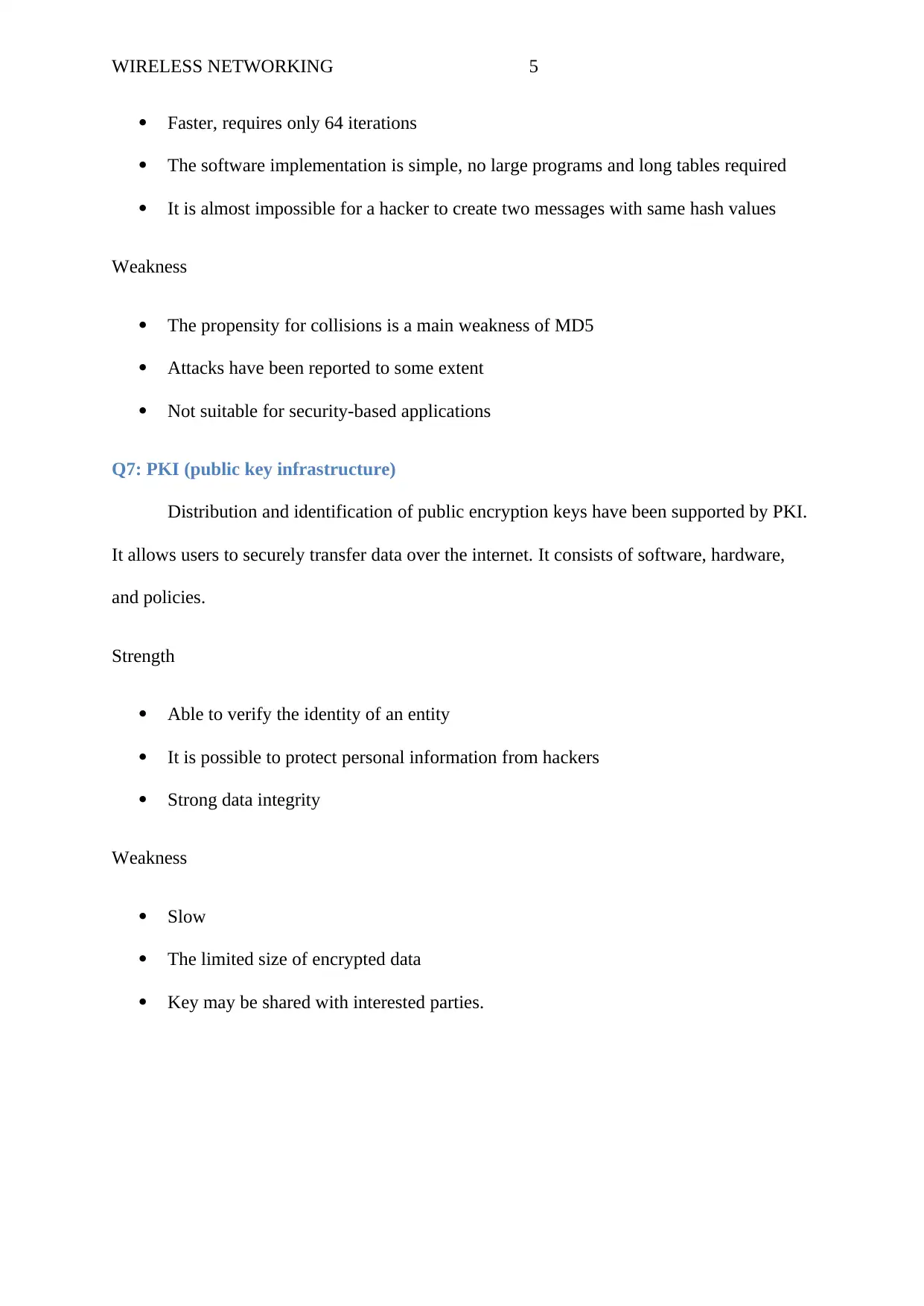
WIRELESS NETWORKING 5
Faster, requires only 64 iterations
The software implementation is simple, no large programs and long tables required
It is almost impossible for a hacker to create two messages with same hash values
Weakness
The propensity for collisions is a main weakness of MD5
Attacks have been reported to some extent
Not suitable for security-based applications
Q7: PKI (public key infrastructure)
Distribution and identification of public encryption keys have been supported by PKI.
It allows users to securely transfer data over the internet. It consists of software, hardware,
and policies.
Strength
Able to verify the identity of an entity
It is possible to protect personal information from hackers
Strong data integrity
Weakness
Slow
The limited size of encrypted data
Key may be shared with interested parties.
Faster, requires only 64 iterations
The software implementation is simple, no large programs and long tables required
It is almost impossible for a hacker to create two messages with same hash values
Weakness
The propensity for collisions is a main weakness of MD5
Attacks have been reported to some extent
Not suitable for security-based applications
Q7: PKI (public key infrastructure)
Distribution and identification of public encryption keys have been supported by PKI.
It allows users to securely transfer data over the internet. It consists of software, hardware,
and policies.
Strength
Able to verify the identity of an entity
It is possible to protect personal information from hackers
Strong data integrity
Weakness
Slow
The limited size of encrypted data
Key may be shared with interested parties.
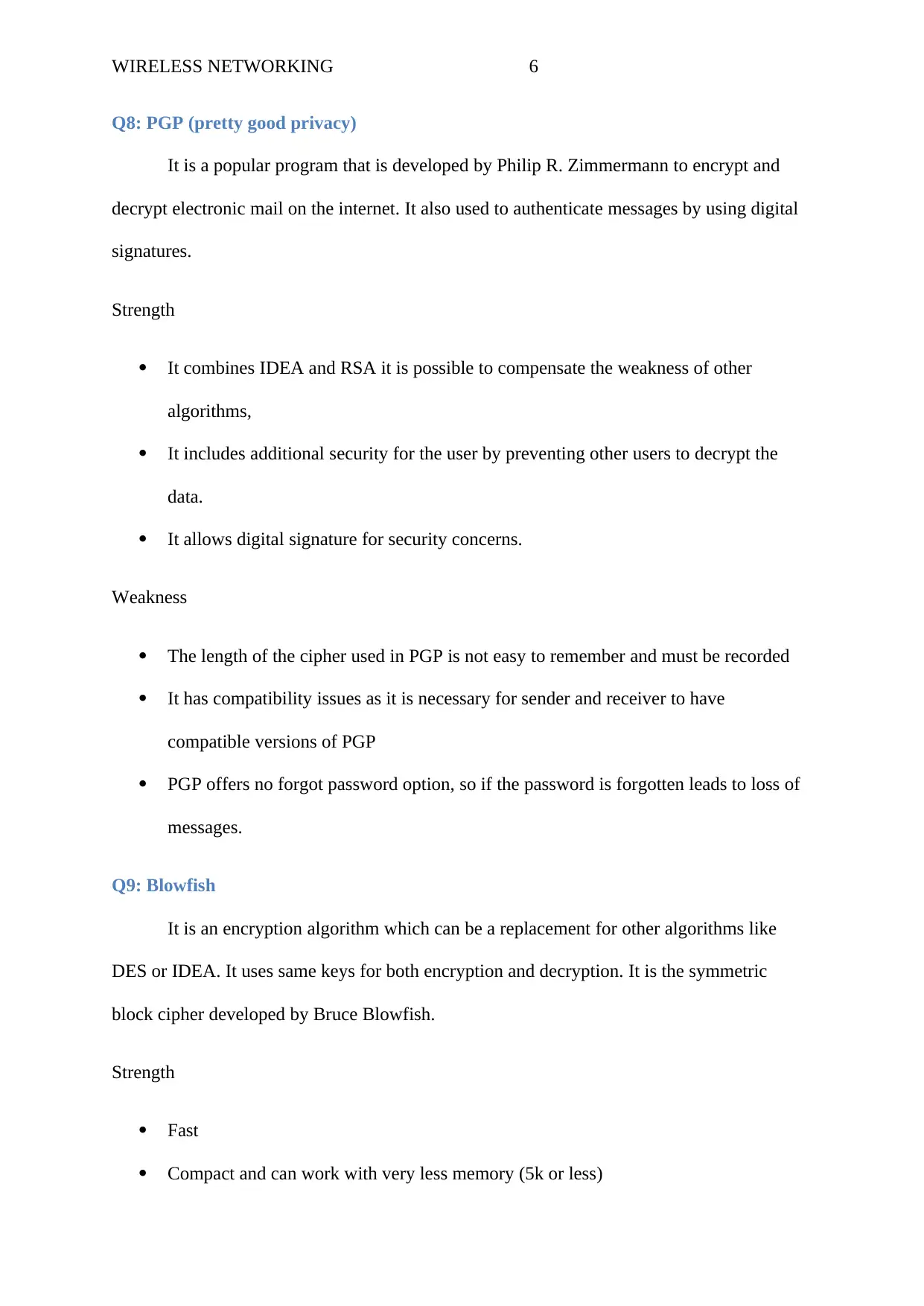
WIRELESS NETWORKING 6
Q8: PGP (pretty good privacy)
It is a popular program that is developed by Philip R. Zimmermann to encrypt and
decrypt electronic mail on the internet. It also used to authenticate messages by using digital
signatures.
Strength
It combines IDEA and RSA it is possible to compensate the weakness of other
algorithms,
It includes additional security for the user by preventing other users to decrypt the
data.
It allows digital signature for security concerns.
Weakness
The length of the cipher used in PGP is not easy to remember and must be recorded
It has compatibility issues as it is necessary for sender and receiver to have
compatible versions of PGP
PGP offers no forgot password option, so if the password is forgotten leads to loss of
messages.
Q9: Blowfish
It is an encryption algorithm which can be a replacement for other algorithms like
DES or IDEA. It uses same keys for both encryption and decryption. It is the symmetric
block cipher developed by Bruce Blowfish.
Strength
Fast
Compact and can work with very less memory (5k or less)
Q8: PGP (pretty good privacy)
It is a popular program that is developed by Philip R. Zimmermann to encrypt and
decrypt electronic mail on the internet. It also used to authenticate messages by using digital
signatures.
Strength
It combines IDEA and RSA it is possible to compensate the weakness of other
algorithms,
It includes additional security for the user by preventing other users to decrypt the
data.
It allows digital signature for security concerns.
Weakness
The length of the cipher used in PGP is not easy to remember and must be recorded
It has compatibility issues as it is necessary for sender and receiver to have
compatible versions of PGP
PGP offers no forgot password option, so if the password is forgotten leads to loss of
messages.
Q9: Blowfish
It is an encryption algorithm which can be a replacement for other algorithms like
DES or IDEA. It uses same keys for both encryption and decryption. It is the symmetric
block cipher developed by Bruce Blowfish.
Strength
Fast
Compact and can work with very less memory (5k or less)
Paraphrase This Document
Need a fresh take? Get an instant paraphrase of this document with our AI Paraphraser
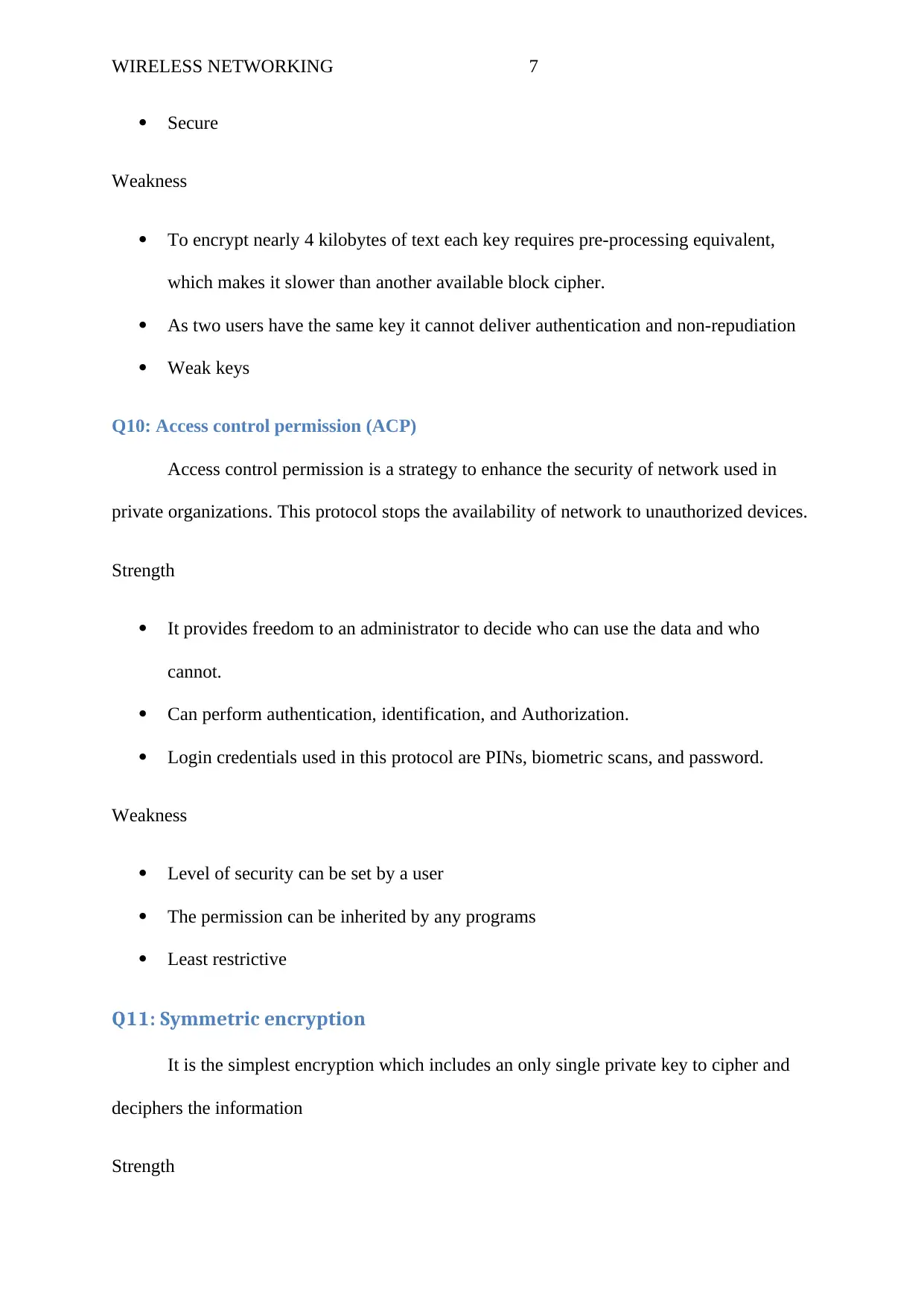
WIRELESS NETWORKING 7
Secure
Weakness
To encrypt nearly 4 kilobytes of text each key requires pre-processing equivalent,
which makes it slower than another available block cipher.
As two users have the same key it cannot deliver authentication and non-repudiation
Weak keys
Q10: Access control permission (ACP)
Access control permission is a strategy to enhance the security of network used in
private organizations. This protocol stops the availability of network to unauthorized devices.
Strength
It provides freedom to an administrator to decide who can use the data and who
cannot.
Can perform authentication, identification, and Authorization.
Login credentials used in this protocol are PINs, biometric scans, and password.
Weakness
Level of security can be set by a user
The permission can be inherited by any programs
Least restrictive
Q11: Symmetric encryption
It is the simplest encryption which includes an only single private key to cipher and
deciphers the information
Strength
Secure
Weakness
To encrypt nearly 4 kilobytes of text each key requires pre-processing equivalent,
which makes it slower than another available block cipher.
As two users have the same key it cannot deliver authentication and non-repudiation
Weak keys
Q10: Access control permission (ACP)
Access control permission is a strategy to enhance the security of network used in
private organizations. This protocol stops the availability of network to unauthorized devices.
Strength
It provides freedom to an administrator to decide who can use the data and who
cannot.
Can perform authentication, identification, and Authorization.
Login credentials used in this protocol are PINs, biometric scans, and password.
Weakness
Level of security can be set by a user
The permission can be inherited by any programs
Least restrictive
Q11: Symmetric encryption
It is the simplest encryption which includes an only single private key to cipher and
deciphers the information
Strength
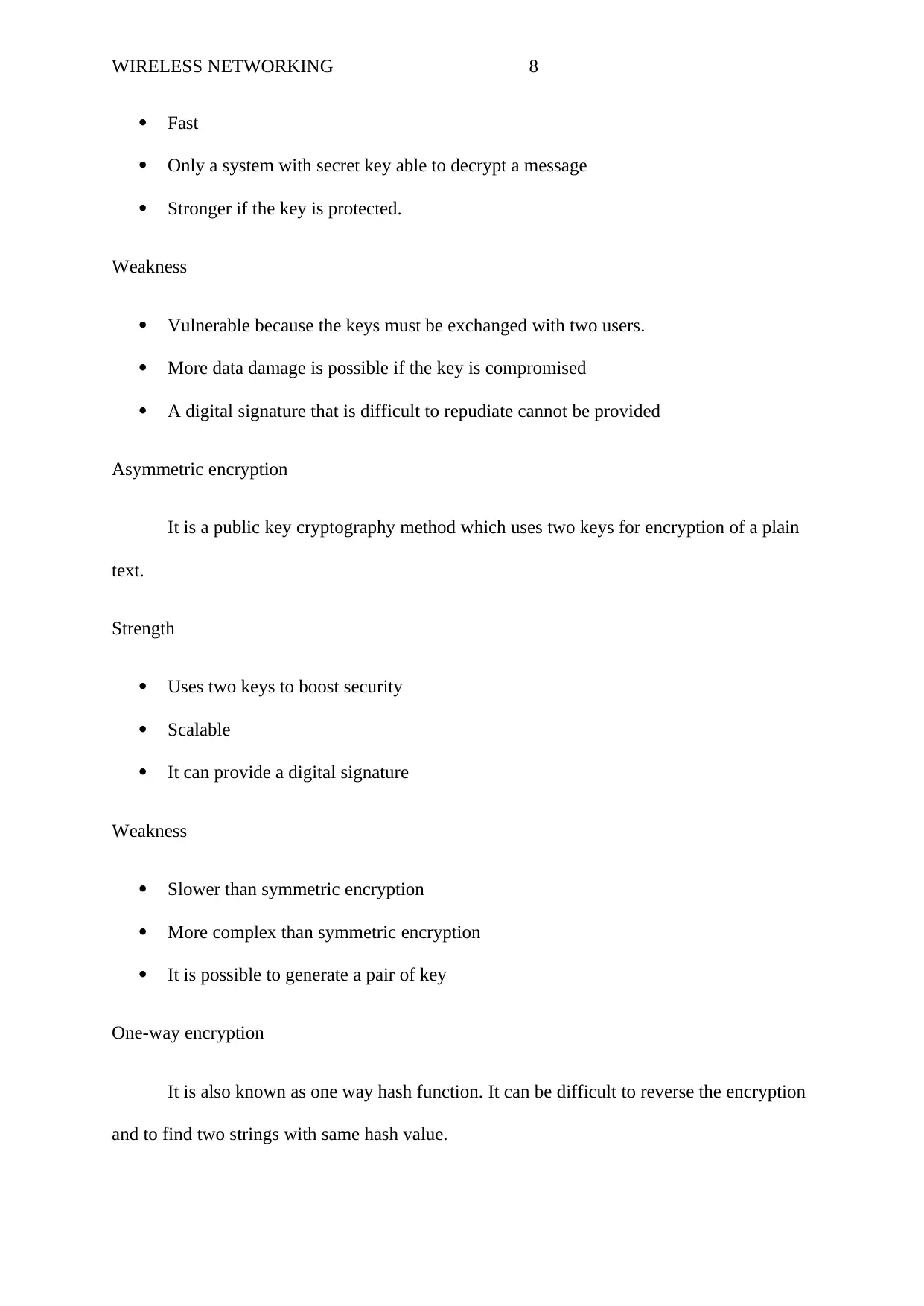
WIRELESS NETWORKING 8
Fast
Only a system with secret key able to decrypt a message
Stronger if the key is protected.
Weakness
Vulnerable because the keys must be exchanged with two users.
More data damage is possible if the key is compromised
A digital signature that is difficult to repudiate cannot be provided
Asymmetric encryption
It is a public key cryptography method which uses two keys for encryption of a plain
text.
Strength
Uses two keys to boost security
Scalable
It can provide a digital signature
Weakness
Slower than symmetric encryption
More complex than symmetric encryption
It is possible to generate a pair of key
One-way encryption
It is also known as one way hash function. It can be difficult to reverse the encryption
and to find two strings with same hash value.
Fast
Only a system with secret key able to decrypt a message
Stronger if the key is protected.
Weakness
Vulnerable because the keys must be exchanged with two users.
More data damage is possible if the key is compromised
A digital signature that is difficult to repudiate cannot be provided
Asymmetric encryption
It is a public key cryptography method which uses two keys for encryption of a plain
text.
Strength
Uses two keys to boost security
Scalable
It can provide a digital signature
Weakness
Slower than symmetric encryption
More complex than symmetric encryption
It is possible to generate a pair of key
One-way encryption
It is also known as one way hash function. It can be difficult to reverse the encryption
and to find two strings with same hash value.
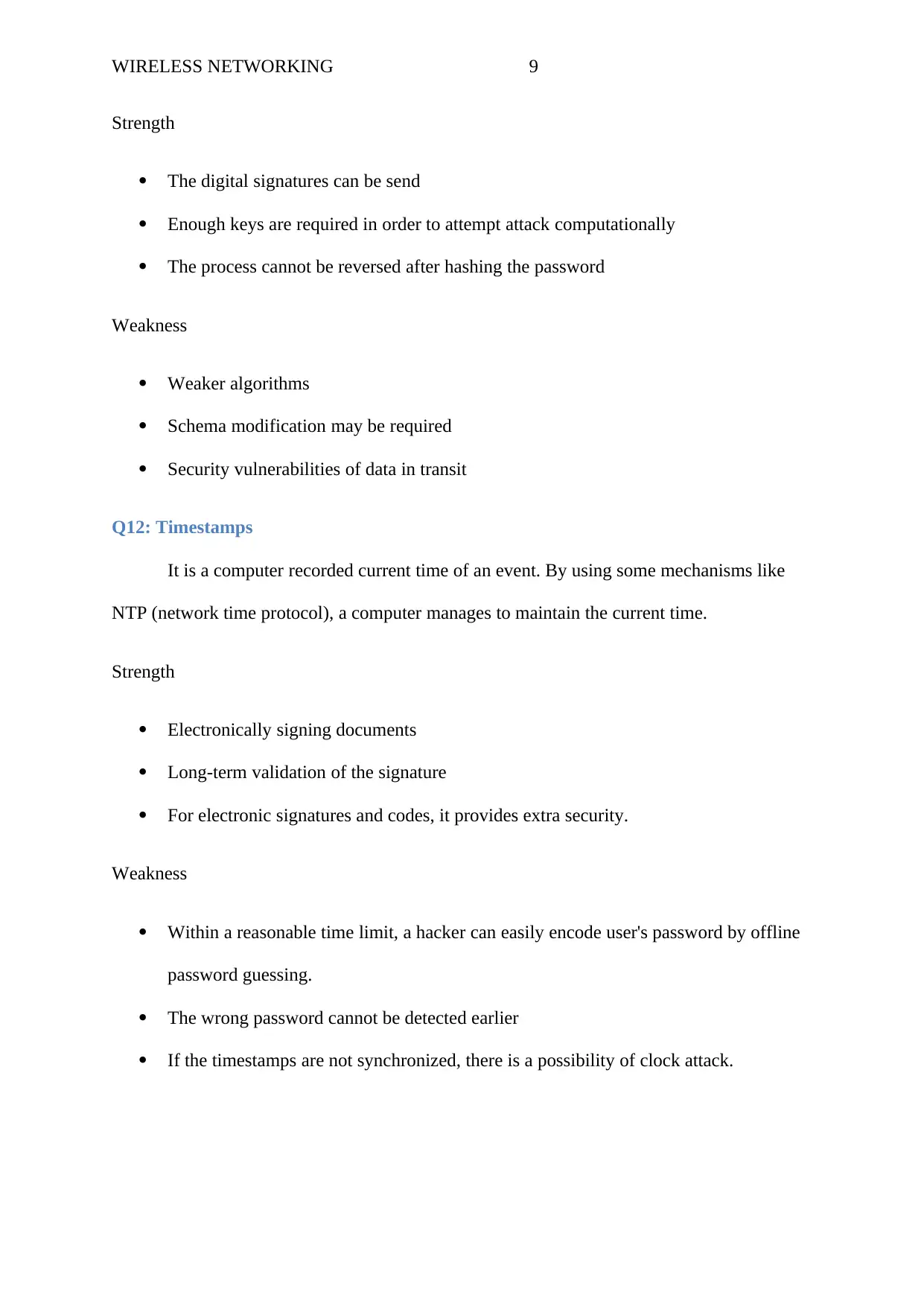
WIRELESS NETWORKING 9
Strength
The digital signatures can be send
Enough keys are required in order to attempt attack computationally
The process cannot be reversed after hashing the password
Weakness
Weaker algorithms
Schema modification may be required
Security vulnerabilities of data in transit
Q12: Timestamps
It is a computer recorded current time of an event. By using some mechanisms like
NTP (network time protocol), a computer manages to maintain the current time.
Strength
Electronically signing documents
Long-term validation of the signature
For electronic signatures and codes, it provides extra security.
Weakness
Within a reasonable time limit, a hacker can easily encode user's password by offline
password guessing.
The wrong password cannot be detected earlier
If the timestamps are not synchronized, there is a possibility of clock attack.
Strength
The digital signatures can be send
Enough keys are required in order to attempt attack computationally
The process cannot be reversed after hashing the password
Weakness
Weaker algorithms
Schema modification may be required
Security vulnerabilities of data in transit
Q12: Timestamps
It is a computer recorded current time of an event. By using some mechanisms like
NTP (network time protocol), a computer manages to maintain the current time.
Strength
Electronically signing documents
Long-term validation of the signature
For electronic signatures and codes, it provides extra security.
Weakness
Within a reasonable time limit, a hacker can easily encode user's password by offline
password guessing.
The wrong password cannot be detected earlier
If the timestamps are not synchronized, there is a possibility of clock attack.
Secure Best Marks with AI Grader
Need help grading? Try our AI Grader for instant feedback on your assignments.
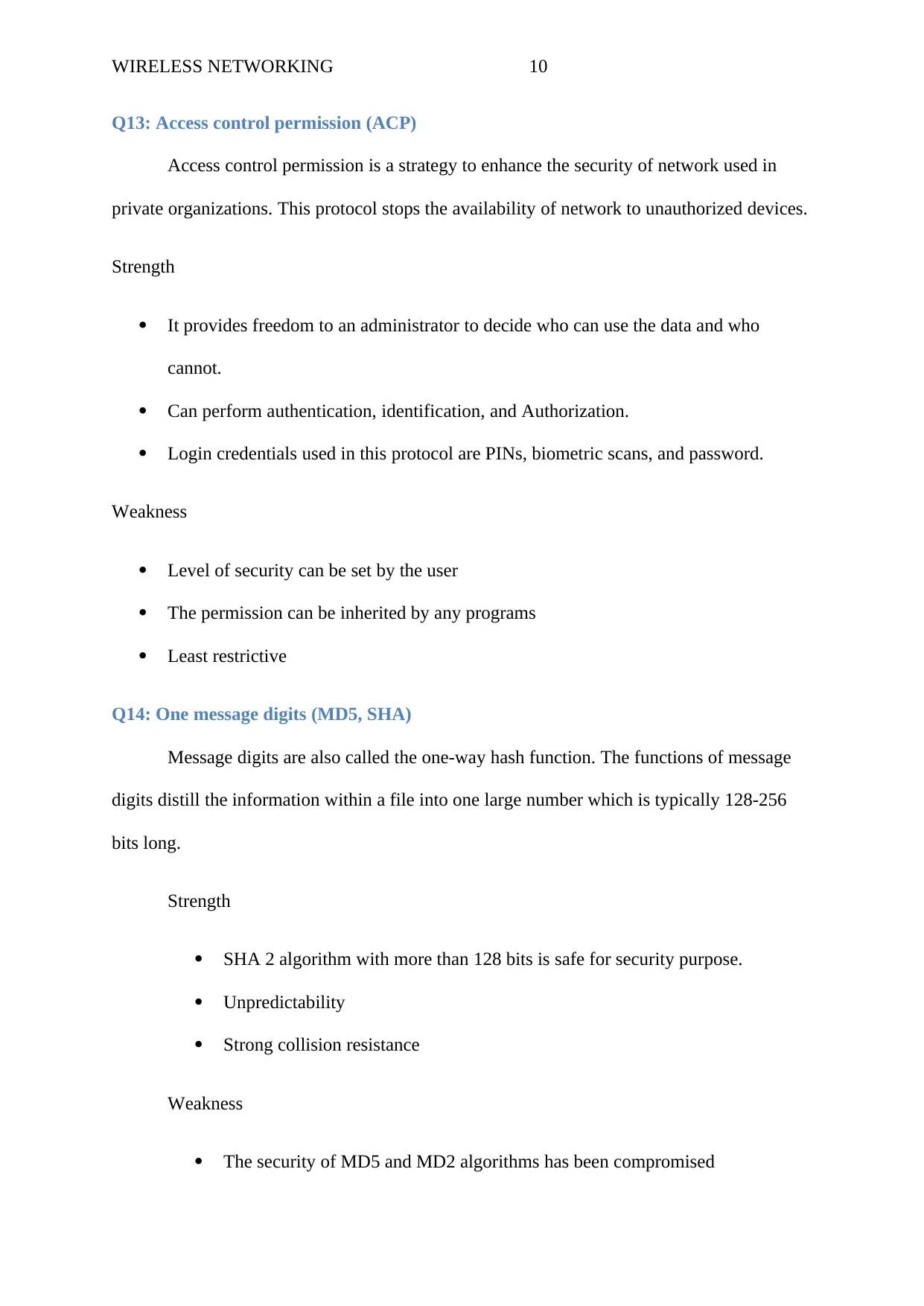
WIRELESS NETWORKING 10
Q13: Access control permission (ACP)
Access control permission is a strategy to enhance the security of network used in
private organizations. This protocol stops the availability of network to unauthorized devices.
Strength
It provides freedom to an administrator to decide who can use the data and who
cannot.
Can perform authentication, identification, and Authorization.
Login credentials used in this protocol are PINs, biometric scans, and password.
Weakness
Level of security can be set by the user
The permission can be inherited by any programs
Least restrictive
Q14: One message digits (MD5, SHA)
Message digits are also called the one-way hash function. The functions of message
digits distill the information within a file into one large number which is typically 128-256
bits long.
Strength
SHA 2 algorithm with more than 128 bits is safe for security purpose.
Unpredictability
Strong collision resistance
Weakness
The security of MD5 and MD2 algorithms has been compromised
Q13: Access control permission (ACP)
Access control permission is a strategy to enhance the security of network used in
private organizations. This protocol stops the availability of network to unauthorized devices.
Strength
It provides freedom to an administrator to decide who can use the data and who
cannot.
Can perform authentication, identification, and Authorization.
Login credentials used in this protocol are PINs, biometric scans, and password.
Weakness
Level of security can be set by the user
The permission can be inherited by any programs
Least restrictive
Q14: One message digits (MD5, SHA)
Message digits are also called the one-way hash function. The functions of message
digits distill the information within a file into one large number which is typically 128-256
bits long.
Strength
SHA 2 algorithm with more than 128 bits is safe for security purpose.
Unpredictability
Strong collision resistance
Weakness
The security of MD5 and MD2 algorithms has been compromised

WIRELESS NETWORKING 11
SHA 0 reported to attacked by collision resistance attacks
SHA 1 cannot be used where collision resistance property is needed
Q15: Replay security
The replay security or anti-replay protocols are a part of IETF and internet protocol
security. By using this protocol it is ensured that for an attacker it will not be possible to
make changes in message packets.
Strength
Impossible to intercept message packets
Against MITM attackers this method provides layer security
It prevents duplicates by providing encryption
Weakness
This protocol sometimes not works properly in some cases.
There is a possibility to arise multiple valid packets with the same sequence
number.
Sometimes good messages that take time to reach will be discarded.
Q16: WEP (Wired Equivalent Privacy)
It was developed for the wireless network and aimed to provide security level. In
1999 it was accepted as Wi-Fi security.
Strength
The RC4 cipher used in this protocol is fairly strong
It does not provide authentication, access control.
There no replay prevention, message privacy, key protection
SHA 0 reported to attacked by collision resistance attacks
SHA 1 cannot be used where collision resistance property is needed
Q15: Replay security
The replay security or anti-replay protocols are a part of IETF and internet protocol
security. By using this protocol it is ensured that for an attacker it will not be possible to
make changes in message packets.
Strength
Impossible to intercept message packets
Against MITM attackers this method provides layer security
It prevents duplicates by providing encryption
Weakness
This protocol sometimes not works properly in some cases.
There is a possibility to arise multiple valid packets with the same sequence
number.
Sometimes good messages that take time to reach will be discarded.
Q16: WEP (Wired Equivalent Privacy)
It was developed for the wireless network and aimed to provide security level. In
1999 it was accepted as Wi-Fi security.
Strength
The RC4 cipher used in this protocol is fairly strong
It does not provide authentication, access control.
There no replay prevention, message privacy, key protection
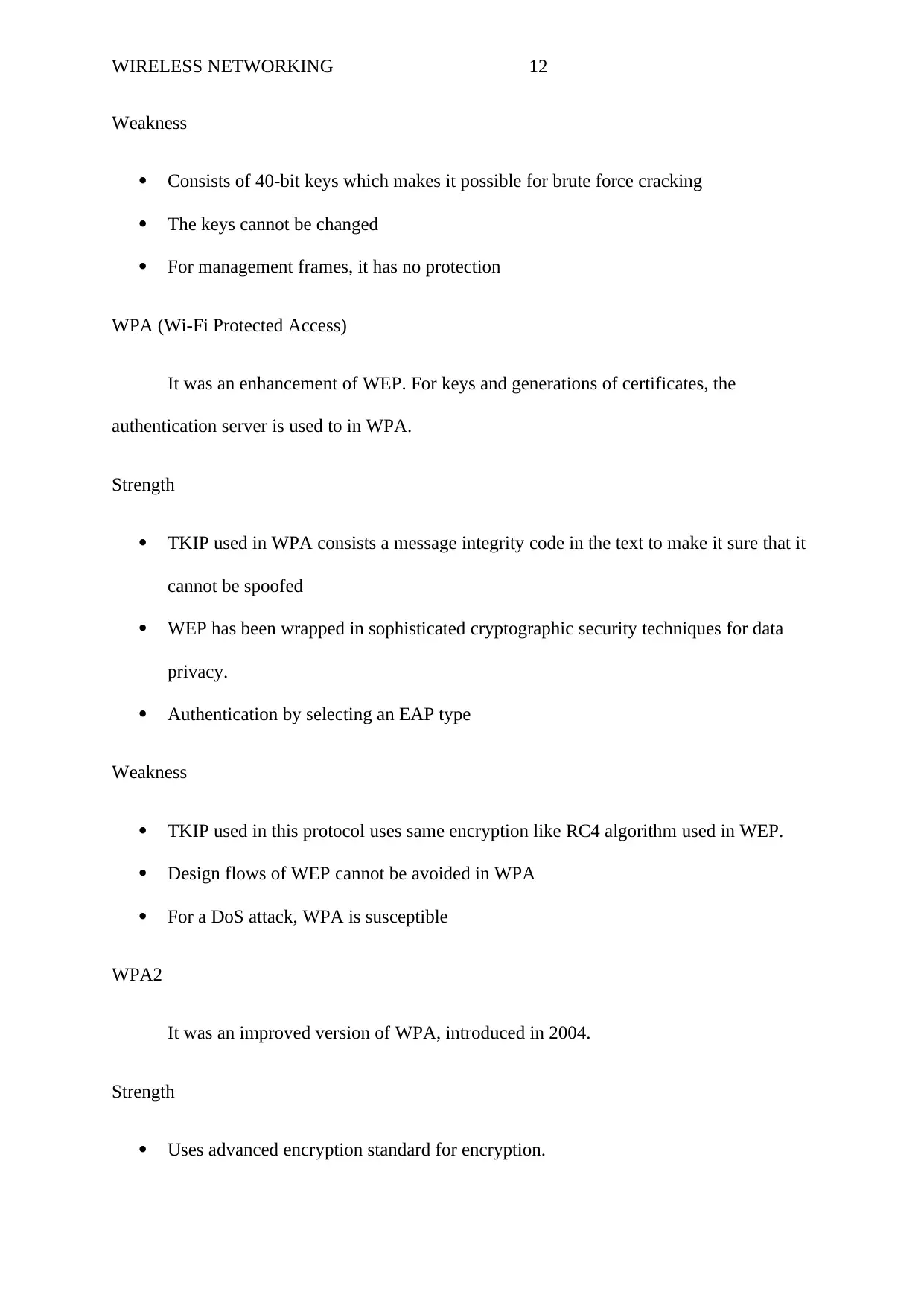
WIRELESS NETWORKING 12
Weakness
Consists of 40-bit keys which makes it possible for brute force cracking
The keys cannot be changed
For management frames, it has no protection
WPA (Wi-Fi Protected Access)
It was an enhancement of WEP. For keys and generations of certificates, the
authentication server is used to in WPA.
Strength
TKIP used in WPA consists a message integrity code in the text to make it sure that it
cannot be spoofed
WEP has been wrapped in sophisticated cryptographic security techniques for data
privacy.
Authentication by selecting an EAP type
Weakness
TKIP used in this protocol uses same encryption like RC4 algorithm used in WEP.
Design flows of WEP cannot be avoided in WPA
For a DoS attack, WPA is susceptible
WPA2
It was an improved version of WPA, introduced in 2004.
Strength
Uses advanced encryption standard for encryption.
Weakness
Consists of 40-bit keys which makes it possible for brute force cracking
The keys cannot be changed
For management frames, it has no protection
WPA (Wi-Fi Protected Access)
It was an enhancement of WEP. For keys and generations of certificates, the
authentication server is used to in WPA.
Strength
TKIP used in WPA consists a message integrity code in the text to make it sure that it
cannot be spoofed
WEP has been wrapped in sophisticated cryptographic security techniques for data
privacy.
Authentication by selecting an EAP type
Weakness
TKIP used in this protocol uses same encryption like RC4 algorithm used in WEP.
Design flows of WEP cannot be avoided in WPA
For a DoS attack, WPA is susceptible
WPA2
It was an improved version of WPA, introduced in 2004.
Strength
Uses advanced encryption standard for encryption.
Paraphrase This Document
Need a fresh take? Get an instant paraphrase of this document with our AI Paraphraser
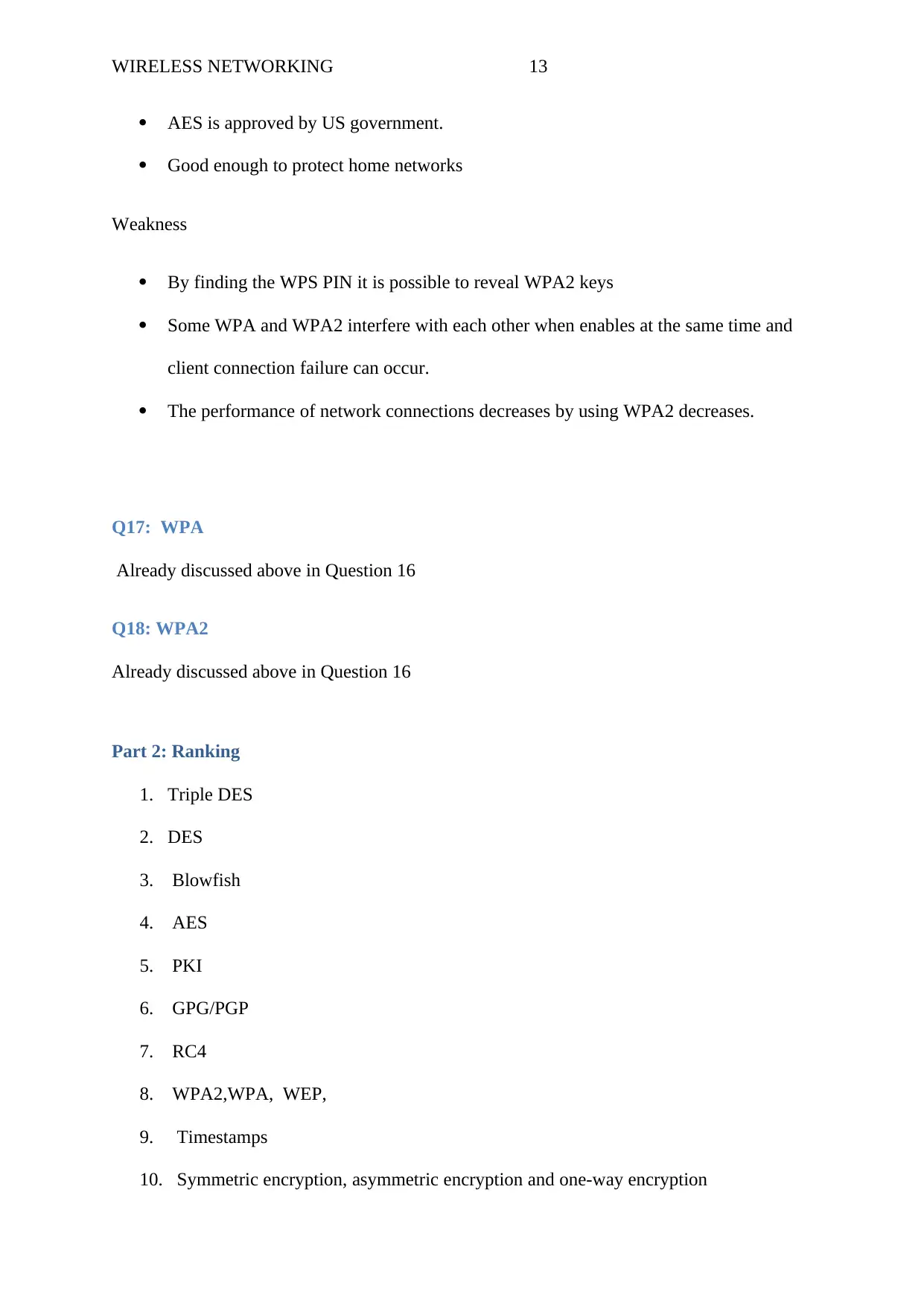
WIRELESS NETWORKING 13
AES is approved by US government.
Good enough to protect home networks
Weakness
By finding the WPS PIN it is possible to reveal WPA2 keys
Some WPA and WPA2 interfere with each other when enables at the same time and
client connection failure can occur.
The performance of network connections decreases by using WPA2 decreases.
Q17: WPA
Already discussed above in Question 16
Q18: WPA2
Already discussed above in Question 16
Part 2: Ranking
1. Triple DES
2. DES
3. Blowfish
4. AES
5. PKI
6. GPG/PGP
7. RC4
8. WPA2,WPA, WEP,
9. Timestamps
10. Symmetric encryption, asymmetric encryption and one-way encryption
AES is approved by US government.
Good enough to protect home networks
Weakness
By finding the WPS PIN it is possible to reveal WPA2 keys
Some WPA and WPA2 interfere with each other when enables at the same time and
client connection failure can occur.
The performance of network connections decreases by using WPA2 decreases.
Q17: WPA
Already discussed above in Question 16
Q18: WPA2
Already discussed above in Question 16
Part 2: Ranking
1. Triple DES
2. DES
3. Blowfish
4. AES
5. PKI
6. GPG/PGP
7. RC4
8. WPA2,WPA, WEP,
9. Timestamps
10. Symmetric encryption, asymmetric encryption and one-way encryption
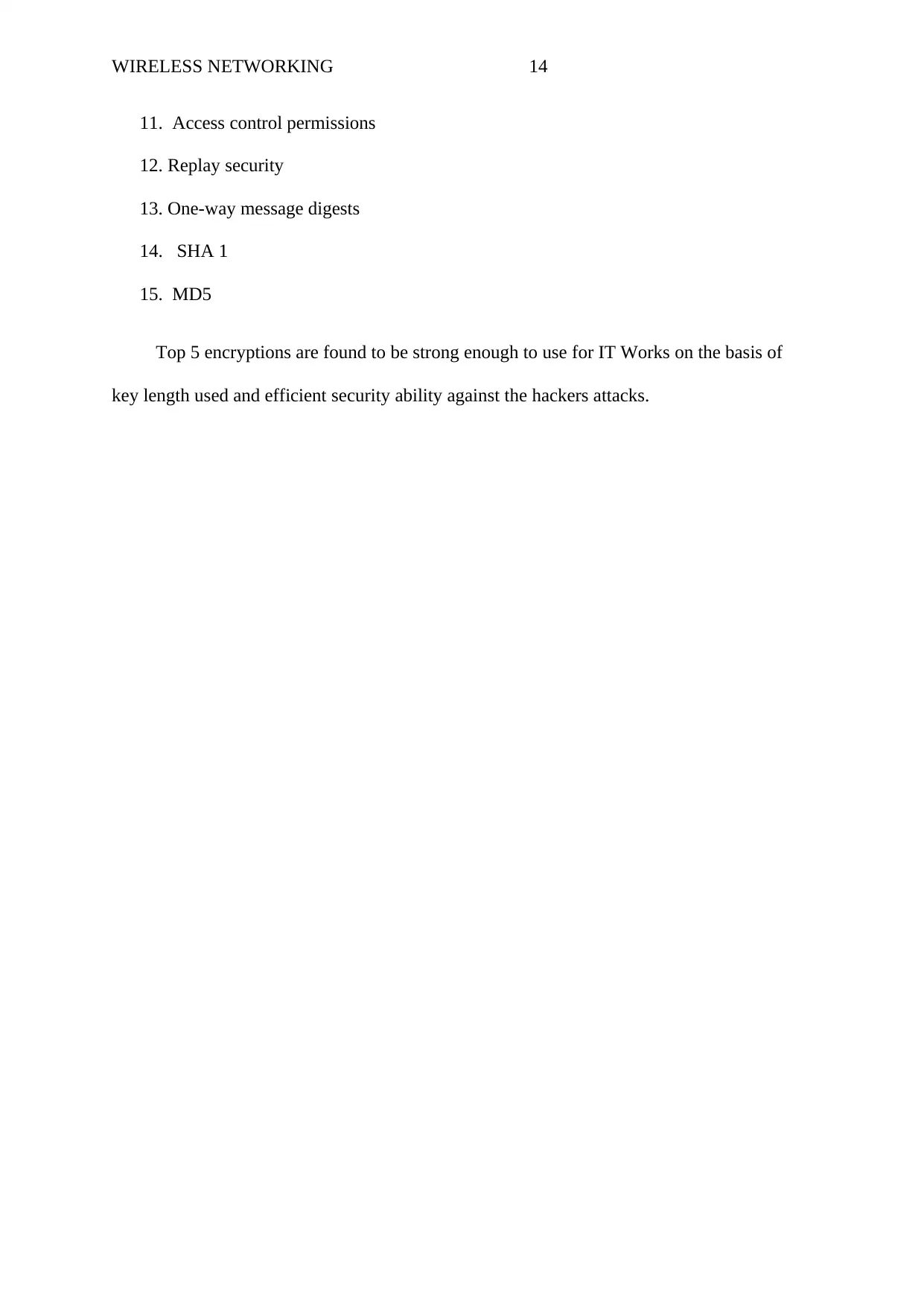
WIRELESS NETWORKING 14
11. Access control permissions
12. Replay security
13. One-way message digests
14. SHA 1
15. MD5
Top 5 encryptions are found to be strong enough to use for IT Works on the basis of
key length used and efficient security ability against the hackers attacks.
11. Access control permissions
12. Replay security
13. One-way message digests
14. SHA 1
15. MD5
Top 5 encryptions are found to be strong enough to use for IT Works on the basis of
key length used and efficient security ability against the hackers attacks.
1 out of 15
Related Documents
Your All-in-One AI-Powered Toolkit for Academic Success.
+13062052269
info@desklib.com
Available 24*7 on WhatsApp / Email
![[object Object]](/_next/static/media/star-bottom.7253800d.svg)
Unlock your academic potential
© 2024 | Zucol Services PVT LTD | All rights reserved.





